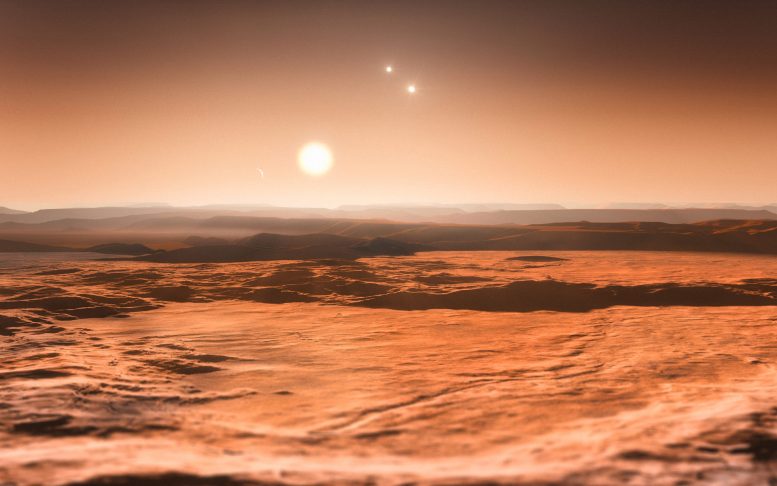
This artist’s impression shows the view from the exoplanet Gliese 667Cd looking towards the planet’s parent star (Gliese 667C). In the background to the right the more distant stars in this triple system (Gliese 667A and Gliese 667B) are visible and to the left in the sky one of the other planets, the newly discovered Gliese 667Ce, can be seen as a crescent. A record-breaking three planets in this system are super-Earths lying in the zone around the star where liquid water could exist, making them possible candidates for the presence of life. This is the first system found with a fully packed habitable zone. Credit: ESO/M. Kornmesser
By adding HARPS observations, along with data from several other telescopes, to previous data about Gliese 667C, a team of astronomers discovered that this system has three super-Earths in the habitable zone where liquid water could exist.
A team of astronomers has combined new observations of Gliese 667C with existing data from HARPS at ESO’s 3.6-meter (11.8-foot) telescope in Chile, to reveal a system with at least six planets. A record-breaking three of these planets are super-Earths lying in the zone around the star where liquid water could exist, making them possible candidates for the presence of life. This is the first system found with a fully packed habitable zone.
Gliese 667C is a very well-studied star. Just over one-third of the mass of the Sun, it is part of a triple star system known as Gliese 667 (also referred to as GJ 667), 22 light-years away in the constellation of Scorpius (The Scorpion). This is quite close to us — within the Sun’s neighborhood — and much closer than the star systems investigated using telescopes such as the planet-hunting Kepler space telescope.
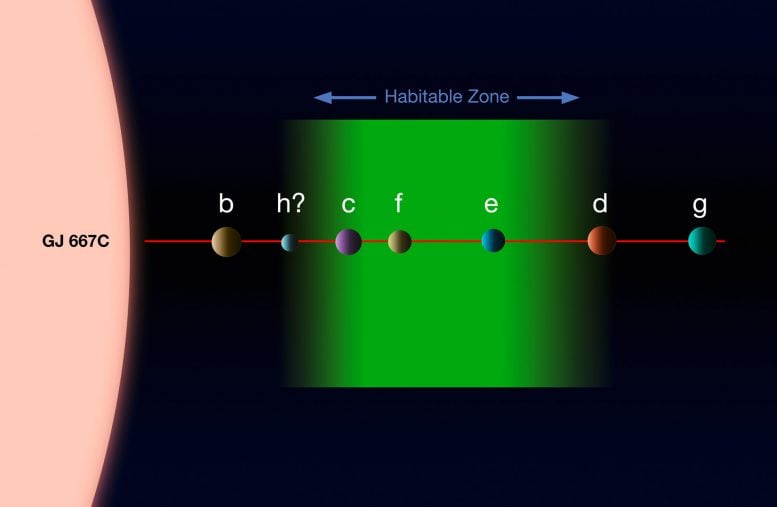
This diagram shows the system of planets around the star Gliese 667C. A record-breaking three planets in this system are super-Earths lying in the zone around the star where liquid water could exist, making them possible candidates for the presence of life. This is the first system found with a fully packed habitable zone. The relative approximate sizes of the planets and the parent star are shown to scale, but not their relative separations. Credit: ESO
Previous studies of Gliese 667C had found that the star hosts three planets (eso0939, eso1214) with one of them in the habitable zone. Now, a team of astronomers led by Guillem Anglada-Escudé of the University of Göttingen, Germany, and Mikko Tuomi of the University of Hertfordshire, UK, has reexamined the system. They have added new HARPS observations, along with data from ESO’s Very Large Telescope, the W.M. Keck Observatory, and the Magellan Telescopes, to the already existing picture [1]. The team has found evidence for up to seven planets around the star [2].
These planets orbit the third fainter star of a triple star system. Viewed from one of these newly found planets the two other suns would look like a pair of very bright stars visible in the daytime and at night they would provide as much illumination as the full Moon. The new planets completely fill up the habitable zone of Gliese 667C, as there are no more stable orbits in which a planet could exist at the right distance to it.
“We knew that the star had three planets from previous studies, so we wanted to see whether there were any more,” says Tuomi. “By adding some new observations and revisiting existing data we were able to confirm these three and confidently reveal several more. Finding three low-mass planets in the star’s habitable zone is very exciting!”
Three of these planets are confirmed to be super-Earths — planets more massive than Earth, but less massive than planets like Uranus or Neptune — that are within their star’s habitable zone, a thin shell around a star in which water may be present in liquid form if conditions are right. This is the first time that three such planets have been spotted orbiting in this zone in the same system [3].
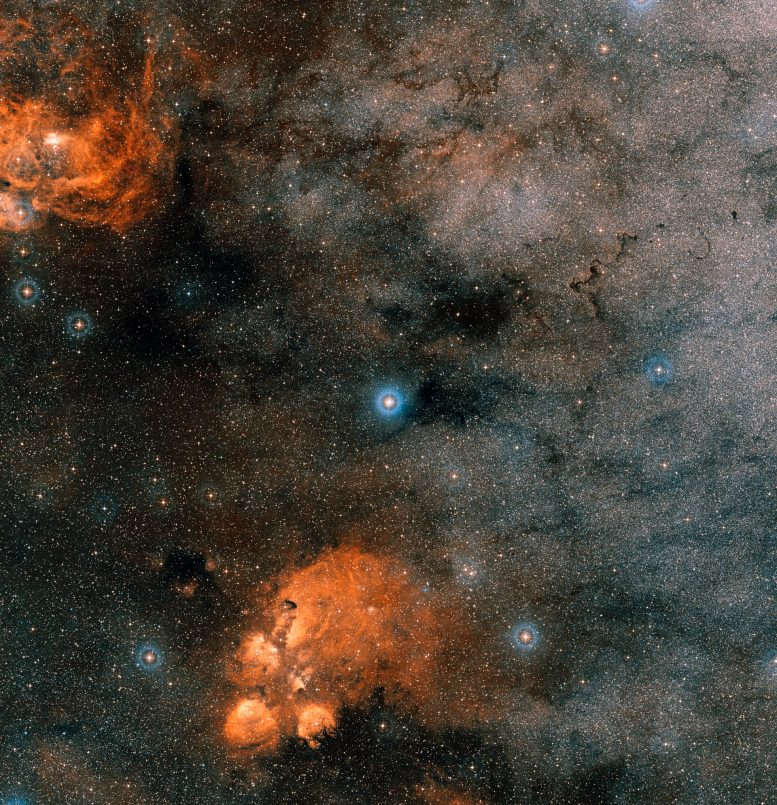
This picture shows the sky around multiple star Gliese 667. The bright star at the center is Gliese 667 A and B, the two main components of the system, which cannot be separated in this image. Gliese 667C, the third component, is visible as a bright star, very close and just under A and B, still in the glare of these brighter stars. The very subtle wobbles of Gliese 667C, measured with high precision spectrographs including HARPS, revealed it is surrounded by a full planetary system, with up to seven planets. Note that this image was assembled from two photographic plates taken years apart through different colored filters. During that time, the motion of the nearby stars Gliese 667AB and C was sufficient for them to appear doubled in this picture, with one red and one blue image of each star. This picture also shows two regions of star formation, much further from Earth than Gliese 667. At the upper-left NGC 6357 is visible and towards the bottom of the picture NGC 6334 (The Cat’s Paw Nebula). Credit: ESO
“The number of potentially habitable planets in our galaxy is much greater if we can expect to find several of them around each low-mass star — instead of looking at ten stars to look for a single potentially habitable planet, we now know we can look at just one star and find several of them,” adds co-author Rory Barnes (University of Washington, USA).
Compact systems around Sun-like stars have been found to be abundant in the Milky Way. Around such stars, planets orbiting close to the parent star are very hot and are unlikely to be habitable. But this is not true for cooler and dimmer stars such as Gliese 667C. In this case the habitable zone lies entirely within an orbit the size of Mercury’s, much closer in than for our Sun. The Gliese 667C system is the first example of a system where such a low-mass star is seen to host several potentially rocky planets in the habitable zone.
The ESO scientist responsible for HARPS, Gaspare Lo Curto, remarks: “This exciting result was largely made possible by the power of HARPS and its associated software and it also underlines the value of the ESO archive. It is very good to also see several independent research groups exploiting this unique instrument and achieving the ultimate precision.”
Anglada-Escudé concludes: “These new results highlight how valuable it can be to re-analyze data in this way and combine results from different teams on different telescopes.”
This video sequence shows an artist’s impression of the view from the exoplanet Gliese 667Cd looking towards the planet’s parent star (Gliese 667C). In the background to the right the more distant stars in this triple system (Gliese 667A and Gliese 667B) are visible and to the left in the sky one of the other planets, the newly discovered Gliese 667Ce, can be seen as a crescent. A record-breaking three planets in this system are super-Earths lying in the zone around the star where liquid water could exist, making them possible candidates for the presence of life. This is the first system found with a fully packed habitable zone.
This video shows the orbital motions of the planets around the star Gliese 667C. Three of these planets are super-Earths orbiting in the habitable zone where liquid water may exist. The orbit of the planet Mercury in the Solar System is included for scale. As Gliese 667C is fainter and cooler than the Sun the habitable zone is much closer to the star than in the Solar System.
Notes
- The team used data from the UVES spectrograph on ESO’s Very Large Telescope in Chile (to determine the properties of the star accurately), the Carnegie Planet Finder Spectrograph (PFS) at the 6.5-meter Magellan II Telescope at the Las Campanas Observatory in Chile, the HIRES spectrograph mounted on the Keck 10-meter telescope on Mauna Kea, Hawaii as well as extensive previous data from HARPS (the High Accuracy Radial velocity Planet Searcher) at ESO’s 3.6-meter telescope in Chile (gathered through the M dwarf program led by X. Bonfils and M. Mayor 2003–2010 described here).
- The team looked at radial velocity data of Gliese 667C, a method often used to hunt for exoplanets. They performed a robust Bayesian statistical analysis to spot the signals of the planets. The first five signals are very confident, while the sixth is tentative, and the seventh is more tentative still. This system consists of three habitable-zone super-Earths, two hot planets further in, and two cooler planets further out. The planets in the habitable zone and those closer to the star are expected to always have the same side facing the star, so that their day and year will be the same lengths, with one side in perpetual sunshine and the other always night.
- In the Solar System Venus orbits close to the inner edge of the habitable zone and Mars close to the outer edge. The precise extent of the habitable zone depends on many factors.
Reference: “A dynamically-packed planetary system around GJ 667C with three super-Earths in its habitable zone” by Guillem Anglada-Escudé, Mikko Tuomi, Enrico Gerlach, Rory Barnes, René Heller, James S. Jenkins, Sebastian Wende, Steven S. Vogt, R. Paul Butler, Ansgar Reiners and Hugh R. A. Jones, 7 August 2013, Astronomy & Astrophysics.
DOI: 10.1051/0004-6361/201321331
PDF

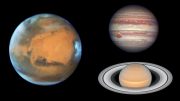
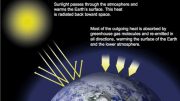
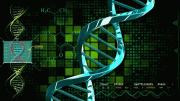
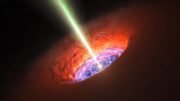
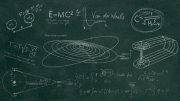

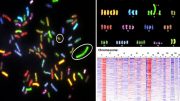

Re: “Nearby” Star GJ 677C:
22 light years sounds feasible if one can travel at the speed of light. If we all don’t take a more active part in maintaining peace, and a healthy, sustainable infrastructure on the planet we are living on, we will be sending refugees into an uncertain future, from a planet that will no longer support human life, like Jor-E and Lara did,with their infant son. We all have a responsibility to try to support the future of this planet, by using our right to vote, and by the way that we treat our fellow humans.
Re: “Supermassive Black Hole” discovery:
Re: Has anyone considered that black holes are portals by which matter is transmitted into less dense areas, to expand and create other universes? The matter is densely compressed to pass through the portal, and expands on the other side, just like our own universe does. What is the plural for universe, anyway? The word is supposed to mean “everything” , but we now suspect that parallel universes exist. I believe that black holes have a lot to tell us, about our own ‘little’ universe. Perhaps each universe is finite, like a sink, and the overflow simply starts other universes, which start other universes, which start other universes, etc…….The better our glasses get, the further we can see, whether the glasses are telescopes or microscopes; but will the one looking through the telescope eventually see the eyes of the one looking through the microscope?
Thank you very much for posting an informative and helpful post.